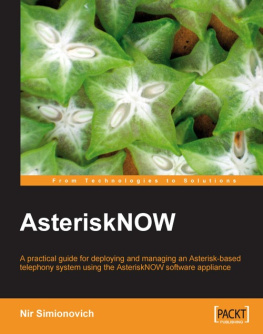Foreword
Asterisk has grown from the very humble beginnings of being my own PBX since I couldn't afford to buy one, and has grown into a world-wide phenomenon, becoming successful due to both the ideas behind it as well as the open-source development model. The usability and usefulness of Asterisk as part of an IP PBX or other telephony system versus a proprietary phone system can be compared in part to the difference between the Betamax and VHS video standards (except, of course that Asterisk is both the open system *and* the best quality system). Betamax, while of an initial high quality, was a proprietary system whose technology could only be advanced by the original creators of the standard. The VHS standard, on the other hand, was made available to a larger development base and thus resulted in more innovation and development. The end result was that the open standard surpassed the proprietary standard in quality, usability, and value. The results are similar as Asterisk has been adopted by a large development community, and resulted in innovation and ease of use that has surpassed traditional technologies.
Every business (and for that matter, pretty much every home) needs a phone system of some level. How to create a system, however, has historically been left to very technical people (even originally in the case of Asterisk). AsteriskNOW, a software appliance which includes Asterisk as well as the AsteriskGUI, was created in order to lower the barrier to use and make setting up one's own phone system much less daunting. In a world of GUI-oriented applications, it made sense to create a GUI which could also be useful as well as inspire innovation and creativity.
The AsteriskGUI, and the code beneath it, is unique compared to other GUIs used in conjunction with Asterisk because the all important Asterisk configuration files can be edited in both the GUI and the command line. Changes made to your IP PBX via the GUI are reflected in the Asterisk configuration files, and vice versa. Thus a novice user, as well as an experienced Asterisk programmer, can use AsteriskNOW in ways that best suit their needs.
Even with AsteriskNOW's ease of use, setting up an IP PBX may not be as easy as it sounds. The book you now hold in your hands is a guide which will assist you in setting up an AsteriskNOW system. If you are new to telephony, you'll gain an understanding of the basic concepts as well. If you are experienced with IP PBX solutions, you'll find information which may help with an AsteriskNOW solution you are developing. The open-source community often provides further assistance for new users on setup, configuration, and creating solutions, and having read this book, you'll get much better support since you've already gotten off to a great start.
Enjoy your experience with Asterisk and AsteriskNOW! And remember to contribute to the ever growing community of Asterisk users and developers who have made it possible for you to create your own PBX, whether it's through code contribution, documentation or just helping other users who are a few steps behind you.
Best Wishes,
Mark Spencer
Original Author and Project Manager, Asterisk CTO, Digium
About the Author
Nir Simionovich has been involved with the open-source community in Israel since 1997. His involvement with the open-source community started back in 1997, when he was a student in the Technion, Israel's Technology Institute in Haifa. Nir quickly became involved in organizing open-source events and promoting usage of Linux and open-source technologies in Israel.
In 1998, Nir started working for an IT consulting company (artNET experts Ltd.), where he introduced Linux-based solutions for enterprises and banks. By 2000, Nir had become a SAIR/GNU-certified Linux trainer and Administrator, slowly educating the future generations of Linux admins.
In 2001, Nir moved to the cellular content market, working for a mobile content delivery company (m-Wise Inc.OTC.BB: MWIS.OB). During his commission at m-Wise, Nir successfully migrated a company that was built purely on Windows 2000 and ColdFusion to open-source technologies, such as Mandrake Linux (today Mandriva), Apache Tomcat, and Kannel (open-source SMS/WAP gateway).
By 2006, Nir had co-founded Atelis (Atelis PLCAIM: ATEL). Atelis is a Digium distributor and integrator. During the course of 2006, Nir developed an Asterisk-based international operator services platform for Bezeq International, which had replaced a Nortel DMS-300 switch. This platform is currently in use by Bezeq International in Israel, serving over 4000 customers a day.
In mid 2007, Nir left Atelis to become a freelance Asterisk promoter and consultant. Nir currently provides Asterisk consulting and development services to various companies, ranging from early-stage start-up companies, through VoIP service providers and VoIP equipment vendors. In his spare time, Nir is the founder of the Israeli Asterisk users group, the website maintainer of the group and an Asterisk developer, dealing mainly with the localization aspects of Asterisk to Israel.
Nir can be reached at <.
I believe the first time I ever used Asterisk was mid 2002. Back then I was working as the IT Director of a start-up company dealing mostly in the mobile market. Our office PBX was a Panasonic PBX, which used to stop working right when we needed it the most. I was frustrated: the PBX in the office never works right and the PBX technicians that come to fix it never do their job right. Being involved in the open-source community since early 1995, I asked myself: "Isn't there an open-source alternative to this?"So, I started searching.
I discovered a few projects, but none were really a complete solution besides a solution that was called Asterisk, from a company in Huntsville called Linux Support Services. I downloaded and installed it, and immediately realized the following: no way would my company migrate from the Panasonic to Asterisk at that point in time. So, I started, learned and understood it and waited for my chance.

